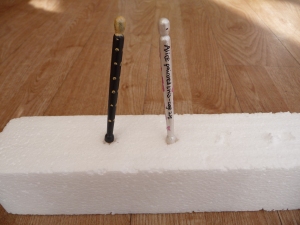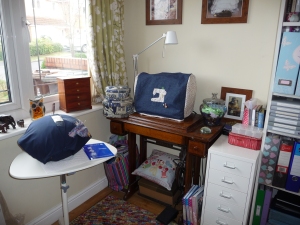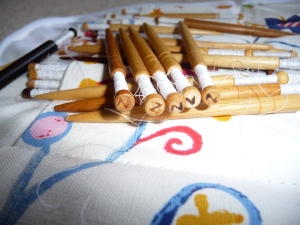Whilst time to actually make lace has been squeezed of late, I have added to my collection of bobbins with a couple of commemoratives. Commemoratives are painted bobbins which celebrate or mark specific occasions, either personal or historic. I have quite a number now, but always get a Happy New Year one from Winslow Bobbins and have commemorated various personal milestones with a painted bobbin from the very talented Sarah Jones. The latest one was to celebrate the birth of my son and adds to the two she made me for the births of my daughters. They love looking for ‘their’ bobbins on my pillow.
Having had a go once at painting bobbins I can completely appreciate Sarah’s talents, and those of anyone who paints bobbins. I took part in a bobbin painting workshop with Jacqui Southworth of Larkholme Lace a year or so ago, and whilst my creations are very, very far from being as good as hers, you may be more skilled in this area and get better results. The ones we did in the workshop were these rainbow ones:
but you can do any design- some of the professionals out there do beautifully intricate designs- check out Sarah Jone’s gallery: http://www.paintedlacebobbins.co.uk/bobbins-gallery Chris Parson’s site: http://www.lace-bobbins.co.uk/bobbins.html and Lacewing designs http://www.lacewingdesigns.co.uk/Decorated%20Bobbins.htm to name but three.
So here’s a quick How To guide on painting bobbins. The instructions below are based on what I can remember from the workshop so my thanks and acknowledgement go to Jacqui.
What will you need:
- A wooden, plain, unpolished bobbin (you can buy these for around 50p each online or in packs of ten)

- Some acrylic paint
- A fine paintbrush

- A paper plate
- Some kitchen roll
- Some water
- Some varnish e.g. Rustins Plastic Coating
- A fine-tipped permanent black pen (if you want to write a message or initial it)
- A steady hand
- A piece of polystyrene (or an equivalent if you can’t abide the stuff) to hold your painted bobbin whilst it dries
What to do:
- Check that the bobbin is free from fluff, grease or anything else.
- Choose your base colour or design and prepare your paint. Dampen the kitchen roll and put it on top of the paper plate. Squirt a few blobs of the paint on (the dampened kitchen roll prevents it from drying out) and mix the colours you want. You hardly need any paint so be sparing!
- Get painting!
- Put the bobbin upside down in the polystyrene until it has dried (it shouldn’t take too long)

- Add any message or initials
- Paint on a layer of varnish. Leave to dry. Then repeat- you’ll probably need around 3-4 coats.
- Spangle the bobbin (if needed)
- Admire, then put it to use. Bobbins are working tools not museum pieces 🙂

Let me know if you try this and how you get on. I’ll definitely try it again but will leave it to the professionals to decorate bobbins to commemorate the milestones in my life!










